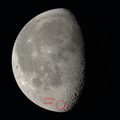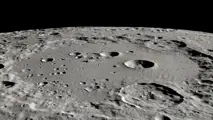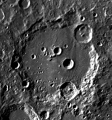
Stargazing Challenges - July 2025
- 23rd Jun 2025
- Author: Dhara Patel
Each month, we'll be sharing a trio of stargazing challenges for you to try your hand at.
This July, see if you're able to find the familiar star pattern known as the Northern Cross asterism, spot the ringed-planet Saturn by the Moon, and grab a pair of binoculars to catch the double star Albireo in the constellation of Cygnus.
Challenge 1 - Northern Cross
On 2 July, can you find the Northern Cross asterism?
We’re having to be patient and stay up later into the night for the skies to darken in the height of summer, but if you can wait until 23:00, look out to the east and try to spot the Northern Cross asterism on 2 July (though it will remain visible in the east at this time throughout the month). This familiar star pattern forms the central - and brightest – part of the constellation of Cygnus the swan. It's made up of five stars in a cross shape. And although it’s not part of the asterism, you may spot a sixth star about halfway between the central star, Sadr, and Albireo, even from light polluted areas.
Taking its name from the Latin word for swan, Cygnus is a prominent constellation in the northern hemisphere during the summer and autumn. Albireo lies at the head of the bird while the star Deneb forms the tail – it’s one of the most luminous naked eye stars despite being one of the most distant.
If you’ve got dark skies and are able to see the Milky Way galaxy, you’ll find that the Northern Cross (and Cygnus) appear to be flying along the plane of our galaxy. As such, the Milky Way is sometimes depicted as a river of stars, with the swan swimming along the galactic river, or acting as a bridge across it.
Peering deeper into the Milky Way, NASA’s Kepler mission launched in 2009 and spent nine years looking at a patch of the sky around the left wing of Cygnus to search for Earth-sized exoplanets (worlds orbiting other stars in our galaxy). Due to this focused mission, over 3,000 exoplanets have been discovered in Cygnus – that’s around half of all known exoplanets at present!
Challenge 2: Moon and Saturn
Can you spot the planet Saturn near the waning gibbous Moon on 16 July?
Midway through the month, on 16 July, try looking out for Saturn beside the Moon in the south-eastern sky. You’ll have to get up quite early unless you’re a night owl that stays up past midnight. The pair will be ideally placed in the south east around 03:00, but you can spot them from midnight when they’ll be low in the east, all the way up until sunrise when they’ll have moved closer to the south.
Saturn is considered to be the most distant planet visible to the naked eye. Lying some 1.5 million kilometres away from us, it will appear like a bright star. (Uranus, the next planet out, is near the limit of human visibility so can only been seen from the darkest and clearest skies). Due to how we see Saturn from Earth as we orbit the Sun, every so often its rings appear to temporarily vanish as we see them edge on – this is known as ring plane crossing. This last occurred in March 2025, so if you look at Saturn now through a pair of binoculars, or preferably a telescope, its rings will look very thin.
In its waning gibbous phase, the Moon is also a great target to observe. Look towards the terminator (the boundary between the lit and unlit sides of the Moon) as this is where the shadows cast by the crater walls really makes them pop and appear more dramatic. In particular, try looking towards the southern part of the Moon and see if you can find the Clavius crater. The crater floor is marked with other smaller craters and when sunlight illuminates the rims of two of these craters – they create a sight known as the ‘Eyes of Clavius’.
Challenge 3 - Albireo, double star
Are you able to catch the double Star Albireo on 30 July?
If you made yourself familiar with Challenge 1 this July – spotting the Northern Cross asterism - have a go at locating the double star Albireo within it. Face towards the east/southeast around 23:00 to find the constellation of Cygnus the swan and in particular the central five bright stars that make up this star pattern - often called the Northern Cross asterism. The star furthest towards the right, representing the head of the swan is called Albireo.
It's estimated that around 50% of stars in our galaxy are in binary (two) or multiple star systems – where stars are close enough together that their gravity keeps them in orbit of each other. But Albireo is not a true binary system as the stars are some 60 light-years apart. Instead, it’s made of two stars that are simply aligned along our line of sight from Earth, so they appear close together. Appearing as a single point to the naked eye, this double star can easily be separated using a pair of binoculars or a telescope. The brighter of the two components called Beta Cygni A appears a golden yellow colour which is a striking contrast to the fainter blue companion known as Beta Cygni B.
The name Albireo comes from the Arabic name "al-Minhar al-Dajajah," meaning "the hen's beak". But Latin scholars likely misunderstood and mistranslated it to "ab ireo" to mean 'from ireus', taking the name to come from an aromatic herb, Ireus. Many stars named from the Arabic language begin with ‘Al’, like Algieba and Aldebaran, so assuming a misspelling, this star came to be known as Albireo.
How did you get on? Were you able to spot our stargazing highlights this month?
If you enjoyed putting your stargazing skills to the test, then keep a look out for the astronomy challenges we'll be sharing each month. And don't forget to share your photos with us using #NSCstargazers
And find out what else you can see this month with our 'What's in the Night Sky' video.
Full references / credits:
(Banner) Skyscape. Credit: © National Space Centre
(1) The Northern Cross on 2 July. Credit: © National Space Centre
(2) Moon and Saturn on 16 July. Credit: © National Space Centre
(2a) Clavius crater on the Moon. Credit: Stellarium
(2b) Clavius Crater. Credit: NASA's Scientific Visualization Studio/USGS
(2c) The Eyes of Clavius. Credit: NASA
(3) The double star Albireo on 30 July. Credit: © National Space Centre







